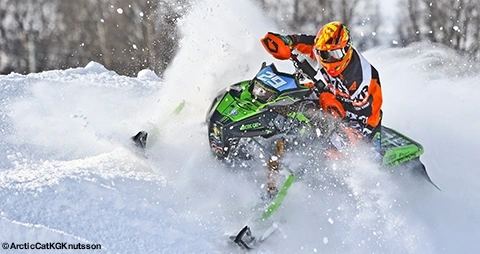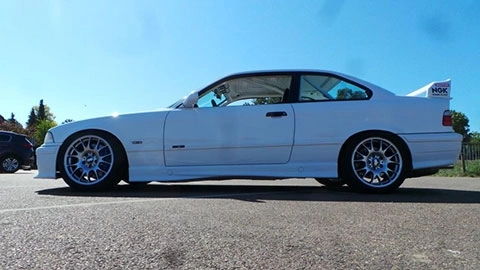Dashing through the snow: All you need to know about snowmobiles before winter hits

Some interesting facts: While most snowmobiles are sold and registered in the US (2018: 1.2 million registered snowmobiles) and Canada (0.6 million), there are also quite a few snowmobile hotspots in Europe: think Siberian Russia, Finnish and Swedish Lapland, glaciers in Iceland, the Tromsø region in Norway, as well as the Swiss, Austrian and German parts of the Alps. Their use varies from the primary source of transportation in remote areas, to recreational enjoyment; and from trail grooming to rescue purposes (for example by ski patrols). “Snowmobiles are more than just a mode of transport, they’re also a lifestyle,” says Mikael Lyckberg, Area Manager Nordic at NGK SPARK PLUG EUROPE. He continues: “They’re used in an environment that challenges man and machine. That’s why they attract not only those who simply enjoy driving, but also riders who are interested in the technical and mechanical aspects of the vehicle.” Because of their uses far off the beaten track and in emergency situations, riders have to make sure their vehicles work – in every eventuality. “As snowmobiles are often used in extreme temperatures, we have to ensure that our specially designed products, like spark plugs and ignition cables, can withstand temperatures of -30°C,” explains Kai Wilschrei, Senior Manager Technical Services Aftermarket EMEA at NGK SPARK PLUG EUROPE. “We offer a wide array of waterproof and moisture-repellent spark plug caps and ignition cables for snowmobiles. Due to our extensive selection, you’ll always find the perfect fit with no risk of loose contacts.” Kai continues: “Ambitious riders might even consider replacing their ignition cable with one from the NGK Racing product ranges. These cables are made of a special compound based on silicone, which remains absolutely elastic and stable under even the most adverse conditions.” | Get set for snow this winter The top ten pre-winter checklist for snowmobile owners from expert Mikael Lyckberg, Area Manager Nordic & Baltic States, NGK SPARK PLUG EUROPE:
Always start by washing your snow scooter, especially if it’s stored outdoors. If the fuel tank is empty, refill with new petrol. If it’s full and the fuel is well preserved, leave it there. If not, it may be time to empty the tank and refill with fresh petrol. This is also a great time to change spark plugs to avoid problems later on. But before you do, it’s a good idea to start the engine and test the old spark plugs, in case of grease or oil residue if you preserved the engine before switching off. When installing new spark plugs make sure you use the correct installation torque, to ensure functionality in all conditions. When replacing your plugs, consider NGK Iridium IX. Their precious metal tip delivers a host of advantages, like improved ignition, longer lifespan, fewer misfires and no carbon build-up. It’s also important to check that your ignition caps and cables are in good shape. Age and water / moisture ingress increase resistance that will cause performance problems. A small service may be useful. Check the oil in the chain housing and change it if necessary. Lubricate all lubrication points according to the service book. |
But back to the numbers: According to the International Snowmobile Manufacturers Association (ISMA) the average snowmobiler is 45 years old, male and loves outdoor sports. There are four million riders globally. Many are members of dedicated clubs: there are more than 3,000 snowmobile clubs globally as well as some non-profit associations, like the Swedish Snowmobile Federation (SNOFED).
The urgency to reach remote, snow-covered areas was a strong driver of innovation in the early days. The first snowmobiles appeared in the early 1900s and were powered by propellers. Russia, with huge areas covered in snow all year round, developed the first so-called Aerosani in 1903. A few years later, in 1911, Harold J. Kalenze patented the Vehicle Propeller in Manitoba, Canada. In the same year, Robert Falcon Scott used early motor sledges for his expedition to the South Pole – but the attempt failed as the vehicles weren’t adapted to local conditions. Canadian inventor Joseph-Armand Bombardier created the first modern snowmobile in 1922.
Here’s another fun fact: The vehicle was originally called a ‘ski-dog’. Sounds familiar, doesn’t it? Purely due to a typographic error, the product line – which is still manufactured by Bombardier Recreational Products (BRP) today – is now globally famous under the name ‘Ski-Doo’.
BRP still is one of the major manufacturers globally, along with Arctic Cat, Polaris and Yamaha Motor Corporation, all based in the US and Canada. One of the main European manufacturers is Alpina, based in Vicenza, Italy. And snowmobiles are also future-proof: Canadian-based Taiga Electric recently created the first electric model.
So have a great winter and stay safe, no matter which vehicle you use. Perhaps you’ll soon get the chance to dash through the snow on a snowmobile!
*According to the International Snowmobile Manufacturers Association (ISMA) Snowmobiling Fact Book, http://www.snowmobile.org/docs/isma-snowmobiling-fact-book.pdf
**According to the United Snowmobile Alliance (USA), https://unitedsnowmobilealliance.com/snowmobile-sales-outperform-economic-growth-worldwide/







